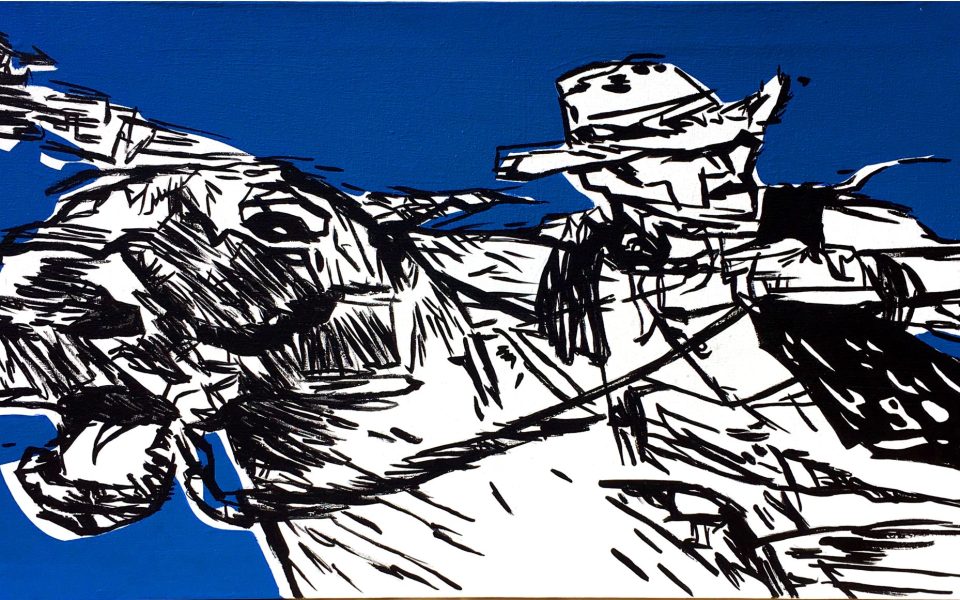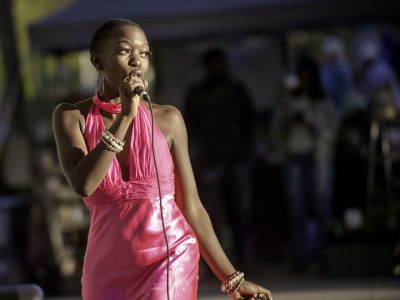The shepherd boy who cried, “Wolf!” met a brutal fate, but what of the wolf?
Revolution Mill’s Central Gallery is displaying Paul Friedrich’s latest exhibition In the Wild — the cartoonist’s continued meditation on this question — through Dec. 16. The born-and-raised Raleighite based the principal Wolves in the Woods series of paintings on his 2017 book The Wolf Who Cried Boy, a twist on the classical fable “The Boy Who Cried Wolf” from Aesop’s Fables.
“It’s the story everyone was told… [but] I realized nobody ever tells the wolf’s point of view, so I decided to tell that story,” Friedrich says. “It actually turns out kind of bloody so a lot of people that pick it up for their kids put it down immediately when they get to the last few pages.”
In Friedrich’s amoral rethinking of the cautionary tale, both the shepherd boy and the wolf repeatedly fail to convince their respective communities that they sighted the other. Village folk grow frustrated with the shepherd boy’s “unfounded” claims but the wolves, too, believe their comrade is “crying boy.” Eventually the lupine protagonist leads his pack to the village; they devour everyone.
Friedrich’s accompanying illustrations are simultaneously goofy and gory, representative of the artistic tightrope he’s made a career traversing. For decades, he’s distilled universal truths through odd and all too familiar characters alike, almost always leaving readers a tad unsettled, whether through rickety lines, uncanny representations or quasi-surrealist compositions. It’s a compelling balancing act.
The easy-on-the-eyes blue, black and white palette chosen for the illustrated book and subsequent acrylic-on-canvas series marks a slight divergence, though his thick-coated frolicsome devils manifest an unsettling look in their eyes just past their alligator-esque jawlines. He’s the author and illustrator of several other graphic novels including Sleepwalking Batman in Plaid Pajamas and Onion Head Monster Attacks, which earned an Eisner Award nomination in 2007 and stars his most recognizable character. He and co-creator Neil Hinson are waiting to hear a decision from Pop TV, best known for the series Schitt’s Creek, regarding their pitch for a television show based on their Man v. Liver cartoon.
He says tides are changing in regard to the art world’s acceptance of cartoon illustration as a legitimate art form.
“Time has proven that just because [cartoons] are accessible doesn’t mean that they’re less than something prestigious,” he says. “A gallery show is wonderful but only a certain percentage of people go there. I’ve had the luck that I’ll show stuff at coffeeshops and bookshops then when I have a gallery show [the gallery] will get a whole new audience that’s following my work.”
He says he’s noticed that he’s served as a bridge between separate social scenes.
“A lot of people still feel that if they don’t have an art history degree they’re not going to be welcomed in a gallery, or they’re going to be lost or intimidated. Then they realize it’s a great place, and see the upcoming schedule and start going on a regular basis.”
Despite a formal arts education, Friedrich considered galleries too highbrow for him until he visited his first a few years after graduating when he got back into painting. The venue was showcasing some of his former high school art teacher’s work that Friedrich wanted to see. He’s a mentee of Bob Rankin, a distinguished local artist, who taught Friedrich at Sanderson High School.
“I started meeting other artists [after college] and it turned out they had all been students of his in high school,” Friedrich says. “Everyone had the same story: how much he’d meant to them, how much he inspired them and had always been there to answer any questions, to guide. When I went to East Carolina, they looked down on cartoons and considered it a waste of talent for me. But he was like, ‘This is what you do, go for it.’”
Calvin and Hobbes, The Far Side, SpongeBob SquarePants and Bugs Bunny are among the cartoons Friedrich loves best.
“Similarities are in the offbeat humor,” he says. “One of the nicest compliments I get a lot is ‘I don’t know why I’m laughing, but I’m laughing.’ It doesn’t always make sense, like The Far Side, but like SpongeBob or Bugs Bunny, my stuff entertains on a lot of different levels for a lot of different age groups and demographics.”
The exhibition’s In the Wild theme isn’t constrained to genre or place; the fable’s woodland wolves share the gallery with dogged cowboy archetypes of the “wild, wild West,” a subject Friedrich revisits every few years. He selected a group of abstract-leaning paintings of forbidding silhouettes from 2014 to juxtapose 2017 Rawhide series works that surge with movement.
“I’m a big fan of Clint Eastwood cowboy movies so a lot of those paintings are based on scenes from those,” he says. “They were movies made for cheap in the mid-to-late ’60s, mostly in Italy, so people started calling them ‘spaghetti westerns.’ At the time, all the American movies were John Wayne style — big and patriotic — and these were dirtier and meaner.”
Deviation from norms, candid tone and grit are certainly among his hallmarks. The Wolf Who Cried Boy’s bloodbath conclusion is viscerally startling albeit cartoony, yet obvious in that wolves will behave as wolves and life is fragile. But this pop artist is not here to moralize; he’s here to remind us to relish the strangeness of our condition and to chuckle at the absurdity of it all along the way.
Join the First Amendment Society, a membership that goes directly to funding TCB‘s newsroom.
We believe that reporting can save the world.
The TCB First Amendment Society recognizes the vital role of a free, unfettered press with a bundling of local experiences designed to build community, and unique engagements with our newsroom that will help you understand, and shape, local journalism’s critical role in uplifting the people in our cities.
All revenue goes directly into the newsroom as reporters’ salaries and freelance commissions.





Leave a Reply